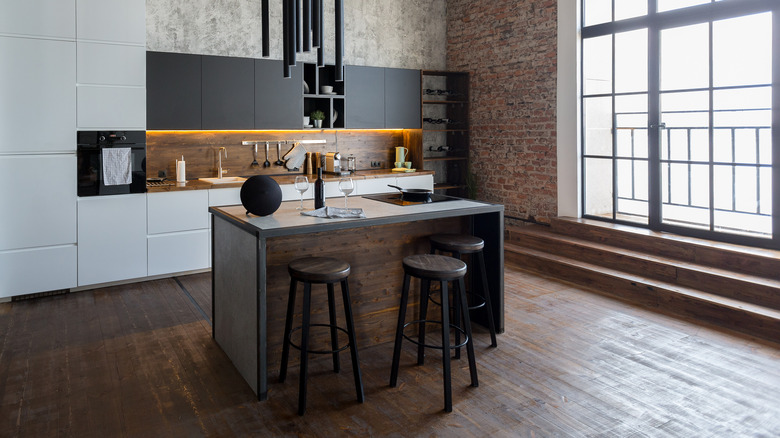How Should Your Kitchen Flooring Coordinate With Your Cabinets?
When it comes to kitchen renovations, the major elements must be functional and attractive, and balancing these two requirements can often make for tricky decision-making. Concerning kitchen floors and cabinets, the material is often a top priority because that directly affects durability. From there, you have to conclude how the two features should match, and the question arises if and how cabinets and flooring should coordinate.
Experts agree that your flooring and cabinetry don't have to match but should still complement each other, according to Floor Factors. The best way to ensure a cohesive design is to make a color palette with two or three shades. Still, this leaves a lot of room for interpretation, or confusion in some cases. Similar to most interior design features, there isn't exactly one way to do this. But there are a few formulas for coordinating cabinets and flooring. Here's everything you need to know.
Lighter floors and darker cabinets
The color of your flooring and cabinets depends heavily on your interior style. Darker cabinets tend to be more traditional, especially in a brown wood tone. A rich dark color for your cabinets can also make your kitchen feel more luxurious, especially when paired with ornate or brass hardware. While darker woods can feel cozy and classic, they can make a space appear smaller. An overwhelming amount of dark wood can absorb the light and make some kitchens feel small and cave-like, mainly if the kitchen is already tiny or lacks natural light.
Pairing dark wood cabinets with lighter floors can help balance that out. Light-colored floors can make a room appear larger, according to Ottawa Diamond Flooring. By reflecting light and mimicking the illusion of space, you can add an airy effect that also helps to highlight your cabinetry. According to CabinetCorp, dark cabinets might be best suited for larger kitchens to help highlight and accent the space.
Monochrome kitchen design
The most popular monochrome kitchen design might be the all-white kitchen. White is contemporary and timeless, making it a favorite for homeowners who want their space to look good for years to come. All-white and other monochrome kitchens utilize cabinets, floors, and other elements of the same color. However, you must be cautious about matching elements in a monochrome design. If the flooring and cabinets are too similar in shade, the design can fall flat and lack definition.
Combat that by choosing slightly different shades and mixing textures, says Kitchen Magic. This can mean using different materials to create varying textures throughout the space. This might mean opting for tile or stone floors rather than wood or wood-looking floors. The sleekness of the tile and stone will contrast with the wood texture of the cabinets. However, wood or wood-looking floors might pair well with glass-front or sleek laminate cabinets rather than wood.
Darker floors for drama
When choosing flooring, many homeowners opt for dark wood floors. The rich colors are more traditional and can also add an air of sophistication to a design, says On Flooring. This is also a great color to use if you want to highlight other design elements. Dark floors will help ground your design and provide the perfect backdrop to show off other features in your kitchen. However, you may want to avoid having dark cabinets with dark floors, as that can create a room that appears too dark. But lighter cabinets paired with darker floors are a great combination.
Darker floors can also add drama; it doesn't always have to be hardwood. Use natural stone or tile to achieve colors that aren't typical for wood stains. A black stone like marble or slate can create a stunning and dramatic design. Dark blue or dark green tile can maintain the dark aesthetic while adding a little color.
Consider your countertops
When coordinating your floors with your cabinets, you don't want to forget to factor in your countertops. You may be able to take cues from the colors found in your countertops to help influence your kitchen floors or cabinets, according to Kitchen Magic. Your counters may be majority white, but if there is gray or black veining throughout the stone, you may use this color for floors or cabinets. That can help create a design that feels cohesive without being too matchy-matchy.
Using this method will require you to pick out your countertops first or know what kind of material you want to use. But seeing the exact slab will make it easier to choose the colors. The colors also don't have to match precisely. The bluish-gray veining may inspire you, but that doesn't mean you have to choose that exact color for your floors or cabinets. Instead, you may opt for another cool-toned gray or muted blue that still pairs well together.
Texture makes a difference
You shouldn't only think about complementing the colors of your floors and cabinets. Varying the textures create a design that's rich and visually interesting, according to Chris & Dick's. Wood is one of the most traditional materials used in the kitchen for floors and cabinets. Use wood for both elements, but be aware of details like graining, which can affect the visual texture of the room. You may also opt to break up the texture by painting the cabinets or using metal pulls.
But you must balance adding and subtracting texture from your space. Too much texture can be overwhelming, creating too much for your eyes to take in at once. However, too little texture can cause your design to look one note, making for a boring room. You also have to be careful since floors and cabinets run into each other. Having textures that are overly similar or different next to each other can mean bad news for your design.





